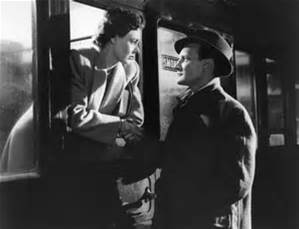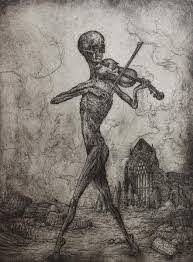Music is a brilliant tool for setting just about any scene and creating any mood.
For starters it can be unashamedly romantic: for example Fred Astaire serenading Ginger Rogers with Jerome Kern’s, The Way You Look Tonight, in the film, Springtime. It doesn’t matter that Fred’s voice wasn’t perhaps the finest, nor that the film, viewed today, has got a bit scratchy. It still makes you want to be floating around a flower-decked ballroom with French windows open to a night garden.
At the other end of the scale it can be heart-wrenching. Celia Johnson in Brief Encounter being brave to an accompaniment of Rachmaninov’s Second Piano Concerto, insisting to Trevor Howard that she is not crying, there’s something in her eye. Would that scene have been as moving without the music?
And on a different level again, it can be rousing – as with Bob Dylan adding his own gravelly note to the Sixties with his stirring anthem of change and protest and rebellion, in The Times They Are a-Changing.
But on yet another level there’s music so dark and so filled with menace that it can churn up real dread for the listener. The opening chords of the iconic and massive Toccata and Fugue – usually ascribed to J. S. Bach and sometimes referred to as storm music – are apt to conjure up images of the classic horror film opening – the ancient crypt, the cobwebbed stone pillars, the overgrown graveyard…
Working out the details of a fifth outing for music researcher and historian, Phineas Fox, it was that impression of dark dread that I wanted to harness and convey to the reader.
There were certainly plenty of music legends and snippets of genuine fact to plunder for a plot. For starters, there was the tale of the virtuoso violinist, Paganini, rumoured to have been involved in black magic practices, and denied burial by the Church for four years. His coffin was trundled half across Europe during those four years, which is surely macabre all by itself. And then there was the odd little story that a veiled woman handed Beethoven a music score, saying he could make use of it, but he must never reveal who had given it to him. That, too, deserves a plot of its own. Also not to be forgotten is the famous legend of a piper wearing multi-coloured – “pied” – clothing, cheated out of payment for rat-catching in a small town in Saxony, and luring children to their deaths with his music by way of punishment…
With that memory of the Pied Piper, came the idea of using death music for a plot.
There’s death music in plenty – with assorted legends as accessories to much of it. There are Dances of Death, Funeral Marches – there are gothic-flavoured pieces, including black metal and dark-wave punk music. Just about every classical composer seems to have dipped a toe into music to celebrate or commiserate death. Chopin wrote a Death March, and so did Handel. Saint-Saens, who generally liked to focus on light-hearted themes, provided the world with the Danse Macabre, while Wagner and Mahler, as is probably to be expected, composed deep, dark pieces – Seigried’s Funeral March in Götterdämmerung from the former, and the Trauermarsch – the Funeral March – by Mahler in his 5th Symphony.
Music is sprinkled with a fair number of saints – St Cecilia is perhaps the best known, but there’s also St Gregory, who gave the world the famous Gregorian Chant. But there are figures from the dark side, as well, and in particular, there’s a medieval devil with a musical quirk to his nature. As devils go, he’s not especially well known, but he’s named, which is useful – all the best exorcists insist that to banish a devil you need to know his name. This one is called Amdusias, and he’s apparently a Grand Duke in the satanic heirarchy, commanding 29 legions. Which presumably isn’t to be sneezed at. His chief claim to fame – maybe that should be infamy – is his ability to whip up an entire orchestral concert at the drop of a forked tongue or the tap of a cloven hoof. The eerie thing about this ability, though, is that while the music was always described as overwhelming, (devils seldom do things by halves), those who claimed to have heard it always insisted they saw no musicians – not the merest shadow of one. Nor did they see any fragment of a music score. It was this last statement that struck me as eerie, because you’d expect even demonic musicians, however talented, to need to consult a score at times, and occasionally to absent-mindedly leave a page or two behind. ‘But,’ say the stories, solemnly, ‘that is the point. Amdusias’s music was never written down’.
Never written down. It was this concept of music that had been remembered and handed down over the ages – but that had never been written down – that caught my interest. Mankind has a marvellous tradition of stories being handed down by word of mouth, of course. All the way back to the tales that were spun around prehistoric cave fires, and to the bards and the Irish shanachie who wore cloaks made of birds’ feathers, and were highly respected members of the community. And perhaps there were occasions when some those stories were so damning or so potentially dangerous that no one had dared to write them down. But could that apply to music? Could there once have been a piece of music that had never been committed to paper because no one had dared to do so?
With this thought, the plot for The Devil’s Harmony, came into being, and with it the music that I eventually called the Dark Cadence. As a side note, originally the music’s title was The Dissonance, and I happily wrote four chapters, before realizing that a Mozart piece had the by-name of the Dissonance Quartet. (Quartet No 19 in C Major, written for two violins, viola and cello, if we’re to be exact).
So, beaten to the post by my all-time favourite composer and Desert Island Disc companion, I cast around for an alternative. And the Dark Cadence came into being.
Phineas Fox, in his fifth musical mystery tour, discovers that the Dark Cadence is indeed death music – but death music of a very particular kind. The fragments of its legend hinted that it had been known as execution music – that it had been played at scaffolds and guillotines and outside death cells, and that it had accompanied many a wretched condemned soul on the last fateful walk to the block or the noose or the firing squad.
But what Phin didn’t know at the start of his investigations was the reason for the fierce secrecy that had always surrounded the Dark Cadence.
Did he uncover the reason? Did he even find the music?
Well, it’s all in the book.
Source: Sarah Rayne Blog



